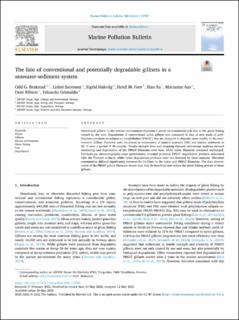| dc.contributor.author | Brakstad, Odd Gunnar | |
| dc.contributor.author | Sørensen, Lisbet | |
| dc.contributor.author | Hakvåg, Sigrid | |
| dc.contributor.author | Føre, Heidi Moe | |
| dc.contributor.author | Su, Biao | |
| dc.contributor.author | Aas, Marianne | |
| dc.contributor.author | Ribicic, Deni | |
| dc.contributor.author | Grimaldo, Eduardo | |
| dc.date.accessioned | 2022-06-16T13:57:47Z | |
| dc.date.available | 2022-06-16T13:57:47Z | |
| dc.date.created | 2022-05-15T08:17:27Z | |
| dc.date.issued | 2022 | |
| dc.identifier.citation | Marine Pollution Bulletin, 2022, 113759, 1-11 | en_US |
| dc.identifier.issn | 0025-326X | |
| dc.identifier.uri | https://hdl.handle.net/11250/2999098 | |
| dc.description.abstract | Abandoned gillnets in the marine environment represent a global environmental risk due to the ghost fishing caused by the nets. Degradation of conventional nylon gillnets was compared to that of nets made of poly- butylene succinate co-adipate-co-terephthalate (PBSAT) that are designed to degrade more readily in the envi- ronment. Gillnet filaments were incubated in microcosms of natural seawater (SW) and marine sediments at 20 ◦C over a period of 36 months. Tensile strength tests and scanning electron microscopy analyses showed weakening and degradation of the PBSAT filaments over time, while nylon filaments remained unchanged. Pyrolysis-gas chromatography/mass spectrometry revealed potential PBSAT degradation products associated with the filament surfaces, while nylon degradation products were not detected by these analyses. Microbial communities differed significantly between the biofilms on the nylon and PBSAT filaments. The slow deterio- ration of the PBSAT gillnet filaments shown here may be beneficial and reduce the ghost fishing periods of these gillnets. | en_US |
| dc.language.iso | eng | en_US |
| dc.publisher | Elsevier | en_US |
| dc.rights | Navngivelse 4.0 Internasjonal | * |
| dc.rights.uri | http://creativecommons.org/licenses/by/4.0/deed.no | * |
| dc.subject | Degradation | en_US |
| dc.subject | Ghost fishing Fate | en_US |
| dc.subject | Marine environment | en_US |
| dc.subject | Gillnets | en_US |
| dc.subject | Plastic | en_US |
| dc.title | The fate of conventional and potentially degradable gillnets in a seawater-sediment system | en_US |
| dc.type | Peer reviewed | en_US |
| dc.type | Journal article | en_US |
| dc.description.version | publishedVersion | en_US |
| dc.rights.holder | © 2022 The Authors. Published by Elsevier Ltd. | en_US |
| dc.source.pagenumber | 11 | en_US |
| dc.source.volume | 180 | en_US |
| dc.source.journal | Marine Pollution Bulletin | en_US |
| dc.identifier.doi | 10.1016/j.marpolbul.2022.113759 | |
| dc.identifier.cristin | 2024644 | |
| dc.relation.project | Norges forskningsråd: 300008 | en_US |
| dc.source.articlenumber | 113759 | en_US |
| cristin.ispublished | true | |
| cristin.fulltext | original | |
| cristin.qualitycode | 1 | |

